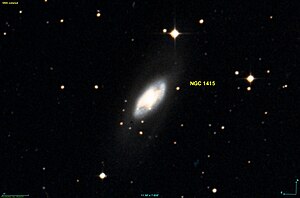NGC 1415
| Galaxy NGC 1415 |
|
|---|---|

|
|
| AladinLite | |
| Constellation | Eridanus |
|
Position equinox : J2000.0 , epoch : J2000.0 |
|
| Right ascension | 03 h 40 m 56.8 s |
| declination | -22 ° 33 ′ 52 ″ |
| Appearance | |
| Morphological type | (R) SAB (s) 0 / a / HII |
| Brightness (visual) | 11.9 likes |
| Brightness (B-band) | 12.8 mag |
| Angular expansion | 3.60 × 1.7 |
| Position angle | 148 ° |
| Surface brightness | 13.8 mag / arcmin² |
| Physical data | |
| Affiliation | Eridanus cluster SSRS group 72 LGG 97 |
| Redshift | 0.005287 ± 0.000023 |
| Radial velocity | 1585 ± 7 km / s |
|
Stroke distance v rad / H 0 |
(67 ± 5) · 10 6 ly (20.4 ± 1.4) Mpc |
| history | |
| discovery | William Herschel |
| Discovery date | December 9, 1784 |
| Catalog names | |
| NGC 1415 • IC 1983 • PGC 13544 • ESO 482-033 • MCG -04-09-047 • IRAS 03387-2243 • 2MASX J03405685-2233520 • SGC 33846-2243.4 • GC 759 • H II 267 • h 2575 • HIPASS J0341- 22 • LDCE 251 NED037 | |
NGC 1415 = IC 1983 is a lenticular galaxy with extensive star formation areas of the Hubble type S0 / a in the constellation Eridanus in the southern sky . It is estimated to be 67 million light years from the Milky Way , about 75,000 light years in diameter, and a member of the Eridanus Galaxy Cluster .
The galaxies NGC 1401 , NGC 1403 , NGC 1416 , NGC 1426 are located in the same area of the sky .
The object was discovered by Wilhelm Herschel on December 9, 1784 .
